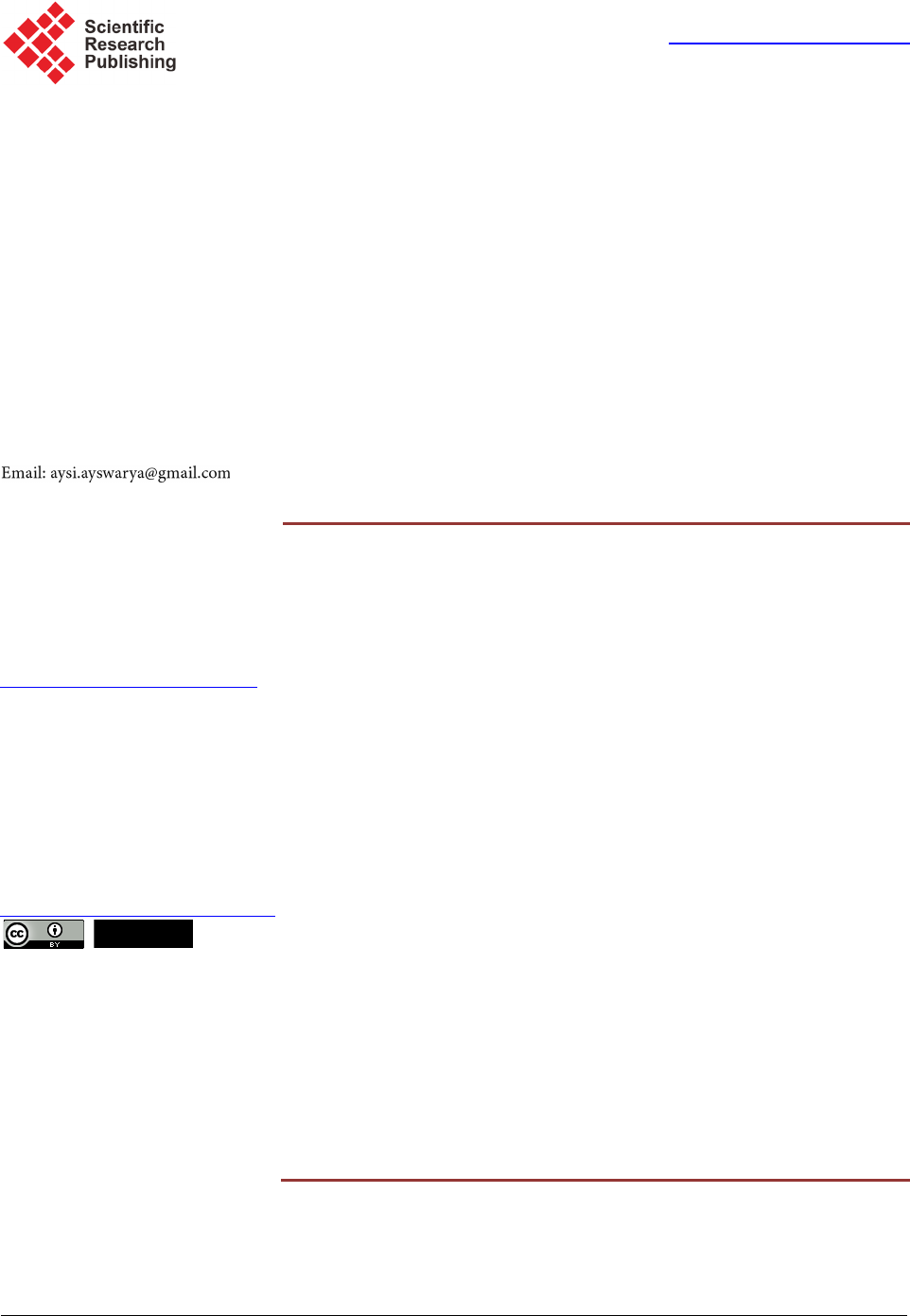
Journal of Service Science and Management, 2019, 12, 649-664
http://www.scirp.org/journal/jssm
ISSN Online: 1940-9907
ISSN Print: 1940-9893
DOI:
10.4236/jssm.2019.125045 Aug. 19, 2019 649 Journal of Service Science
and Management
Service Quality of Mobile Banking Services in
ICICI Bank Limited
R. Ayswarya
1
, D. Sarala
1
, P. Muralidharan
2
, M. Ilankadhir
3
1
PG & Research Department of Commerce, Cauvery College for Women
(Autonomous), Tiruchirappalli, India
2
Department of Commerce, St. Joseph’s College of Commerce (Autonomous), Bangalore, India
3
School of Management Studies, Sathyabama Institute of Science and Technology, Chennai, India
Abstract
Purpose:
Mobile banking is the latest and most innovative service offered by
Banks. The purpose of the study is to investigate the determinants of service
quality of mobile banking services in ICICI.
Methodology: This study was
conducted by using empirical research and Cluster cum Simple random sam-
pling method has been adopted for a sample size of 100 respondents using
mobile banking services in ICICI bank Limited.
Findings: 35 percent of the
respondents are using the SMS mode of mobile banking services. The dimen-
sions of service quality factors of mobile banking services maintained by
ICICI Bank Ltd are Co
nvenience, Responsiveness, Security, Accessibility,
Assurance, Knowing the customer and efficiency mobile banking services.
The factors that satisfy the customers’
level towards mobile banking services
offered by ICICI Bank Ltd. are banking activities, banking products and
other
services. The reasons for using mobile banking services are Convenient ser-
vices, Time-saving and quick service.
Originality/Values:
This paper shows
that the mobile banking service quality dimensions are an important factor to
satisfy the customers. The outcomes of this study enhance the kno
wledge on
the performance of ICICI bank as well as customer satisfaction, which are in-
valuable to all the bank managers and industry players in improving their
services.
Keywords
Customer Satisfaction, Service Quality, Mobile Banking Services
1. Introduction
Currently, mobile banking is a quite widespread banking system in the world.
How to cite this paper:
Ayswarya, R.,
Sarala
, D., Muralidharan, P. and Ilankadhir,
M
. (2019) Service Quality of Mobile Bank-
ing Services in ICICI Bank Limited
.
Journal
of
Service Science and Management
,
12,
649
-664.
https://doi.org/10.4236/jssm.2019.125045
Received:
July 10, 2019
Accepted:
August 16, 2019
Published:
August 19, 2019
Copyright © 201
9 by author(s) and
Scientific
Research Publishing Inc.
This work is licensed under the Creative
Commons Attribution International
License (CC BY
4.0).
http://creativecommons.org/licenses/by/4.0/
Open Access

R. Ayswarya et al.
DOI:
10.4236/jssm.2019.125045 650 Journal of Service Science
and Management
Many banks are started to provide mobile banking services. Mobile banking is a
financial transaction conducted by logging on to the bank’s website by using a
handphone or cell phone [1]. The global smartphone penetration forecast shows
that around 50 percent of mobile users worldwide are projected to own a smart
device as of 2018 [2]. The mobile phone penetration is rounding up to 67 per-
cent in 2019 [3]. 60 percent of customers have used mobile banking this year to
check account balance, view recent transactions, pay bills, transfer funds or
other banking needs. 73 percent made a purchase with a mobile app that can be
used at many different retailers; 64 percent paid an individual through a bank’s
app; 62 percent paid an individual through a payment service’s app. Smart-
phones have become more affordable and the falling mobile data prices have
helped the internet to reach a bigger mass of the country’s huge population. It
indicates that there is an increase in mobile penetration in India. This penetra-
tion helps to implement the mobile banking system effectively and it will help to
bring all sections of people into the banking system.
Mobile banking makes the change in the traditional processing of the bank’s
works. Mobile banking helps them to transfer and do all the activities in the
same place without moving anywhere. Based on the attitude of the customer
there is a change in the behaviour banking process with the help of mobile
banking which is more comfortable. So, the entire bank started to develop their
activities with the help of mobile banking which is effectively used by the cus-
tomers. Mobile Banking has become one of the important factors that have been
effectively used by the consumer, based on this the updating of banks has to be
done to retain and satisfy the customers. Mobile Banking updates their products
then knowledge of the behavioural intention to adopt mobile with the usage for
transfer of amount, funds, credit, debit, etc. So, mobile banking performed be-
tween bankers and its customers in the form of Short Message Service (SMS),
application-based, the mobile internet, etc., for the purpose of attaining higher
levels of customer satisfaction and increased loyalty by providing any time and
any where banking results in reduction of administrative expenses, lesser num-
ber of branches and lower handling charges with service to the customers.
In the present scenario, the banking sector of India is running in a dynamic
challenge concerning both customer base and performance. Service quality is an
indispensable competitive strategy to retain the customer base. Banks are trying
to focus on customer satisfaction by giving them enhanced quality services. [4]
So the study has examined the customer satisfaction and service quality of mo-
bile banking services in ICICI Bank Ltd. The service quality of banking services
has been measured using SERVQUAL (service quality) scale. In the present
banking system, excellence in customer service and service quality is the most
important tool for sustainable business growth.
2. Theoretical Background
This study predicts great Mobile banking potential in Indian banks as Indian

R. Ayswarya et al.
DOI:
10.4236/jssm.2019.125045 651 Journal of Service Science
and Management
banks will aim to target online banking users without regular access to the
internet but are very likely to own mobile devices. This report of Vital Analytics
recommended huge potential of mobile banking in India, as the study found that
checking account balance is the most frequently cited reason by Urban Indian
customers’ for using Mobile Banking. This report has found that 40 million Ur-
ban Indians used their mobile phones to access their bank account balances fol-
lowed by accessing the last three transactions [5]. This research work compared
the Indian public sector and private sector banks in terms of customer satisfac-
tion and to study the variety of service quality using the SERVQUAL model.
This research work uses both the sources of information,
i.e.
primary and sec-
ondary sources and thereafter the SERVQUAL model has been used to identify
the discrepancy in the service delivery system. Finally, the study concludes by
giving some recommendations to improve in the area where these banks do not
meet the expectation of their customers [6]. This paper focuses on adoption and
usage of m-banking services among Indian banking industries as well as cus-
tomers and include the challenges & difficulties of m-banking services like high
charges, slow data transmission and insecurity. Customer is not much aware of
mobile banking in compare with ATM, credit card, debit card, etc. [7]. This
study focuses on m-banking performance with the help of special programmed
called clients downloaded to the mobile device. This paper suggests solutions
that have been designed to support multiple channels across the entire customer
life cycle. This study identifies the mindset and analyses the security issues in
Mobile banking among the banking customers in India. Primary data was col-
lected from 65 respondents using an online questionnaire in this study. Secon-
dary data was also used from the website of the Telecom Regulatory Authority of
India (TRAI). The findings indicate that most of the respondents are using
online banking facility from their respective banks. However, around 25 percent
of customers are using Mobile banking and the remaining 75 percent are not [8].
This study examined the adoption and impact of Mobile banking on customers
of different banks located in Delhi. A survey opinion of 200 customers was con-
ducted. ANOVA and Factor Analysis have been used and there were five factors
identified; Security/Privacy, Reliability, Efficiency and Responsiveness on the
basis of understanding of customer’s perception regarding Mobile banking. The
results indicate that demographic factors can have a significant impact on cus-
tomer perception [9]. This study also revealed on factors affecting mobile bank-
ing services—an empirical study on the adoption of mobile banking mode of
services, presently the Internet technology has brought the third revolution to
this world. In this study identifies mobile banking technology which is the third
era of technology of banking sector after phone and net banking and compara-
tively its growth is phenomenal when compared to the first two eras. Even in In-
dia the Mobile Banking is growing fast because of the world’s largest subscriber
base in the mobile sector after China [10]. This study focused on changing con-
sumer behaviour for mobile banking services in India that has been explored
towards the consumer satisfaction of the new electronic payment service as mo-

R. Ayswarya et al.
DOI:
10.4236/jssm.2019.125045 652 Journal of Service Science
and Management
bile banking and the factors influencing the adoption of mobile banking services.
[11]. This study explains technologies in the banking sector have made our life
very easy. This paper is to find out the awareness and level of Satisfaction to-
wards ICICI bank Customers using ATM Service in Coimbatore city. For this
study purpose, primary data were used and 100 respondents were collected in
ICICI. Data were tabulated and analysed with the help of statistical tools to
achieve the objectives of the study [12].
3. Empirical Results
Research Model
Empirical study has been adopted. This study was conducted to assess and
analyse the customer satisfaction and service quality of mobile banking services
in ICICI bank ltd in Tiruchirappalli Town. This empirical study was conducted
using the following methodology.
Statement of the Problem
Mobile banking can play a big role in taking banking services to the remote
area. The competition in the banking sector is increasing rapidly as the number
of players in the industry is increasing. Mobile banking is expected to improve
banks service quality in a form of transactional convenience, saving of time, cost
and quick transaction alert. Realizing the increase in mobile penetration in In-
dia, now banks and other financial institutions are offering various services
through mobile phones. Hence, a research study is required to assess the cus-
tomer satisfaction and service quality of mobile banking service in ICICI bank
Limited to find answers for the following questions.
Are the customers satisfied with the mobile banking services offered by ICICI
bank ltd.?
How is the service quality of mobile banking service maintained in ICICI
bank Ltd.?
What will be the reason for using mobile banking service?
Whether the customers are facing any problems in mobile banking services
offered by ICICI Bank Ltd.?
In order to find out the reasons for the mentioned questions above, the re-
searcher had framed the objectives below.
Objectives of the Study
To assess customer satisfaction towards mobile banking services offered by
ICICI bank Ltd.
To analyse the mobile banking services under the dimensions of service qual-
ity.
To assess the main reasons for using mobile banking services.
Scope of the Study
With the increasing penetration and usage of mobile banking, net banking
and other internet banking facilities, the concerns with regard to safety and se-
curity of online banking transactions have also escalated Bank has advised that
all the users and customers should set-up pin/password for mobile banking, reg-

R. Ayswarya et al.
DOI:
10.4236/jssm.2019.125045 653 Journal of Service Science
and Management
ister/update the mobile number, e-mail ID for instant alerts keep a track of all
banking transactions. Mobile banking as a service has been increasingly accepted
as a medium through which customers may operate their account transactions
anywhere and anytime. This study is confined to the customers within Ti-
ruchirappalli Town. The study will be able to reveal that increase the level of sat-
isfaction of the customers regarding the mobile banking services and the service
quality of the mobile banking in ICICI bank. It also motivates them to use mo-
bile banking services efficiently. It also helps banks to know whether the prod-
ucts or services they are offering are really satisfying the customers’ needs. This
study brings the attention of management towards the importance of training
and development of customers of mobile banking.
Hypothesis
H
0
1
: There is a significant association between Monthly income and the period
of being a customer at ICICI Bank Ltd.
H
0
2
: There is a significant difference between age and respondents often use
mobile banking services.
Data Collection & Tools Used
Both primary and secondary data are used for the study but the analysis was
made mainly using primary data. The data regarding customer satisfaction and
service quality of ICICI Bank Ltd. were collected through the well-structured
questionnaire. The questionnaire was used to collect data from the respondents
who are using mobile banking services in ICICI Bank Ltd. in Tiruchirappalli
Town. The information has been collected from books, journals and websites
from the internet. Percentage analysis, Chi-square, one-way ANOVA and Factor
analysis have been used for the analysis and interpretation. The statistical tools
are used to analyse the data to answer the objective structure.
Sampling Technique
A sample of 100 respondents is approached for the study and analysed. Clus-
ter cum simple random sampling technique is used for the survey. Area of the
study refers to Tiruchirappalli Town, TamilNadu. There are 12 ICICI branches
in Tiruchirappalli Town and the population is 1,167,485 approximately. The re-
searcher has taken only one branch for this study,
i.e.
Thillai Nagar branch.
With the known population, the sample size is determined for the study using
the following formula by Dr. Todd L. Grande.
(
)
( )
2
2
2
2
1
1
1
Zp p
e
n
Zp p
eN
⋅
⋅
−
=
−
+
where
n
= sample size,
z
= confidence level (
z
score value),
e
= margin error,
N
=
population size,
p
= population percent. Hence the sample size is equal to 385.
Form the known population of 1,167,485 with 4 percent margin of error at a
95 percent confidence level with 50 percent population. Therefore, the sample
size is taken for the study is 100.

R. Ayswarya et al.
DOI:
10.4236/jssm.2019.125045 654 Journal of Service Science
and Management
Limitations of the Study
The study is limited to the geographical region of Tiruchirappalli town. Due
to time constraints, the researcher has collected data from 100 respondents only.
4. Results
Table 1 showes that out of 100 respondents, It is inferred that majority of the
respondents are in the age group of 21 - 30 years. Majority of the respondents
are female
. Majority of the respondents are postgraduate. Majority of the re-
spondents are doing business. Majority of the respondents are in the Rs. 20,001 -
Rs. 50,000. Majority of the respondents have been a customer for 1 - 5 years.
Majority of the respondents know about the mobile banking services offered by
ICICI Bank Ltd through a customer of the bank. Majority of the respondents are
using SMS banking mode of mobile banking services.
To identify the service quality of mobile banking services in ICICI bank ltd,
the factor analysis technique has been used. The 18 factors are identified namely
Q1, Q2, Q3, ∙∙∙ Q18 was given in
Table 2.
Table 2 reveals that Kaiser-Meyer-Olkin Measure of Sampling Adequacy
(KMO) and Bartlett’s test of sphericity has been applied to the resultant correla-
tion matrix to test whether the relationship among the variables has been sig-
nificant or not as shown in the table. The result of the test shows that with the
significant value of 0.000 there is a significant relationship among the variables
chosen. KMO test has yielded a result of 0.561 which states that service analysis
can be carried out appropriately for these variables that are taken for the study.
Table 3 observes that the reliability of coefficient alpha (
α
) for the 100 cases of
18 items is 0.736 (scale range from 0.0 to 1.0) which shows the reliability of the
given factors.
Table 4 illustrates that the principal component analysis and rotated factors
loading method is used for stimulating factors. It is observed that out of 18 ser-
vices, 7 factors are identified by the rotation method. The total percentage of
variation in the factors shows 67.114 percent.
Table 5 shows that clustering for service quality of mobile banking services in
ICICI bank Limited. It shows that variables 3 qualities Q8, Q13, Q17 are cluster
as factor 1 and is named as “Convenience”. The next 4 variables Q6, Q11, Q14,
and Q18 are cluster as Factor 2 and are named as “Responsiveness”. The next 3
variables Q9, Q10, Q12 are cluster as Factor 3 and are named as “Security”. The
next 3 variables Q1, Q2, Q15 are cluster as Factor 4 and are named as “Accessi-
bility”. The next 2 variables Q4, Q7 are cluster as Factor 5 and are named as
“Assurance”. The next 2 variables Q5, Q16 are cluster as Factor 6 and are named
as “Knowing the Customer”. The next 1 variable Q3 is cluster as Factor 7 and is
named as “Efficiency”.
Hence the factor that stimulates the service quality of mobile banking services
in ICICI bank limited is given below:
1) Convenience;

R. Ayswarya et al.
DOI:
10.4236/jssm.2019.125045 655 Journal of Service Science
and Management
Table 1. Demographic of the respondents.
Factors
Classification
Frequency
Percent
Gender
Male 47 47
Female
53
53
Total 100 100
Age (In Years)
Below 20 years 5 5
21 to 30 years
38
38
31 to 40 years 28 28
41 to 50 years 19 19
Above 51 years 10 10
Total 100 100
Educational Qualification
Under graduate 29 29
Postgraduate
36
36
Professional 19 19
Diploma 13 13
Others 3 3
Total 100 100
Occupation
Professional 18 18
Business
25
25
Government employee 22 22
Private employee 23 23
Others 12 12
Total 100 100
Monthly Income
(In Rupees)
Below Rs. 20000 23 23
Rs. 20,001 - Rs. 50,000
42
42
Rs. 50,001 - Rs. 100,000 25 25
Above Rs. 100,001 10 10
Total 100 100
Period Of Being A
Customer in ICICI Bank Ltd.
Less than 1 years 16 16
1 - 5 years
42
42
6 - 10 years 35 35
Above 10 years 7 7
Total 100 100
Mobile Banking Services
Offered By ICICI Bank Ltd.
Advertisement 27 27
SMS/E-MAILS 27 27
Customer of the bank
30
30
Employees of the bank 12 12
Others 4 4
Total 100 100
Mode of Using Mobile
Banking Service
Wireless application protocol (WAP) 33 33
Unstructured supplementary data (USSD) 8 8
SMS banking
35
35
Application-based SMS/GPRS 24 24
Total 100 100
Source: computed from primary data.

R. Ayswarya et al.
DOI:
10.4236/jssm.2019.125045 656 Journal of Service Science
and Management
Table 2. Service quality of mobile banking services in ICICI bank Ltd.
KMO and Bartlett’s Test
Kaiser-Meyer-Olkin Measure of Sampling Adequacy. 0.561
Bartlett’s Test of Sphericity
Approx. chi-square 425.553
df 153
Sig. (0.000)**
Table 3. Reliability analysis on service quality.
No. of Cases
No. of Items
Reliability Coefficient Alpha
100 18 0.736
Table 4. Rotated factor loadings on service quality.
Service Quality
Factors
1
2
3
4
5
6
7
Provide relevant &
accurate information-Q1
0.637
Update technology
regularly-Q2
0.771
Maintaining accurate
record-Q3
0.868
The bank is willing to
help customers and provide
prompt service-Q4
0.631
Get Immediate help for
problem or queries-Q5
0.692
Prompt responses to the
requests by SMS/email
or other means-Q6
0.643
Mobile hackers may not take
control of my account-Q7
0.774
Safe to do transactions-Q8
0.697
Secure credit/debit card or
other pin information-Q9
0.547
Save time-Q10
0.762
Information content and texts
are easy to understand-Q11
0.559
Reading characters on
the website is easy-Q12
0.682
Availability of customer
service for 24 * 7-Q13
0.832

R. Ayswarya et al.
DOI:
10.4236/jssm.2019.125045 657 Journal of Service Science
and Management
Continued
Anywhere and
anytime banking-Q14
0.725
Solve the banking
problems quickly-Q15
0.721
Easy to contact
the bank-Q16
0.783
Speed of login to
account is fast-Q17
0.513
Reducing the
waiting time-Q18
0.589
Percentage of Variance 11.124 10.628 10.522 9.764 8.780 8.686 7.609
Cumulative percentage 11.124 21.752 32.774 42.038 50.818 59.505 67.114
Source: primary data. Extraction method: principal Component Analysis.
Table 5. Clustering of stimulating factor in service quality of mobile banking services in
ICICI bank ltd.
Factor
Particulars
Rotated Factor
Loadings
1) Convenience
(11.124 Percent)
Safe to do transactions-Q8 0.697
Availability of customer service for 24 * 7-Q13 0.832
Speed of login to account is fast-Q17 0.513
2) Responsiveness
(10.628 Percent)
Prompt responses to the requests by
SMS/email or other means-Q6
0.643
Information content and texts are easy to
understand-Q11
0.559
Anywhere and anytime banking-Q14 0.725
Reducing the waiting time-Q18 0.589
3) Security (10.522 Percent)
Secure credit/debit card or
other pin information-Q9
0.547
Save time-Q10 0.762
Reading characters on the website is easy-Q12 0.682
4) Accessibility
(9.764 Percent)
Provide relevant & accurate information-Q1 0.637
Update technology regularly-Q2 0.771
Solve the banking problems quickly-Q15 0.721
5) Assurance (8.780 Percent)
The bank is willing to help customers
and provide prompt service-Q4
0.631
Mobile hackers may not take control of
my account-Q7
0.774
6) Knowing the Customer
(8.686 Percent)
Get Immediate help for problem or queries-Q5 0.692
Easy to contact the bank-Q16 0.783
7) Efficiency (7.609 Percent) Maintaining accurate record-Q3 0.868

R. Ayswarya et al.
DOI:
10.4236/jssm.2019.125045 658 Journal of Service Science
and Management
2) Responsiveness;
3) Security;
4) Accessibility;
5) Assurance;
6) Knowing the Customer;
7) Efficiency.
To identify the respondents’ level of satisfaction towards the mobile banking
service in ICICI bank ltd, the factor analysis technique has been used. The 10
factors are identified namely S1, S2, S3, ∙∙∙ S10 was given in
Table 6.
Table 6 reveals that Kaiser-Meyer-Olkin Measure of Sampling Adequacy
(KMO) and Bartlett’s test of sphericity has been applied to the resultant correla-
tion matrix to test whether the relationship among the variables has been sig-
nificant or not as shown in the table. The result of the test shows that with the
significant value of 0.000 there is a significant relationship among the variables
chosen. KMO test has yielded a result of 0.621 which states that service analysis
can be carried out appropriately for these variables that are taken for the study.
Table 7 observes that the reliability of coefficient alpha (
α
) for the 100 cases of
10 items is 0.661 (scale range from 0.0 to 1.0) which shows the reliability of the
given factors.
Table 8 illustrates that the principal component analysis and the rotated fac-
tor loading method is used for stimulating factors. It is observed that out of 10
services, 4 components are identified by the rotation method. The total percent-
age of variation in the factors shows 63.563 percent.
Table 9 shows that clustering of stimulating factor in the level of satisfaction
towards mobile banking services in ICICI bank limited. It shows that variables 4
services Q2, Q3, Q7 and Q9 are cluster as factor 1 and is named as “Banking ac-
tivities”. The next 3 variables Q1, Q5, Q8 are cluster as factor 2 and is named as
“Banking products”. The next 2 variables Q6, Q10 are cluster as factor 3 and is
named as “Other services”. The next 1 variable Q4 is cluster as factor 4 and is
named as “Other services”.
Table 6. Respondents level of satisfaction towards the mobile banking services in ICICI
bank Ltd.
KMO and Bartlett’s Test
Kaiser-Meyer-Olkin Measure of Sampling Adequacy. 0.621
Bartlett’s Test of Sphericity
Approx. chi-square 161.621
df 45
Sig. (0.000)**
Table 7. Reliability analysis of level of satisfaction.
No of Cases
No of Items
Reliability Coefficient Alpha
100 10 0.661

R. Ayswarya et al.
DOI:
10.4236/jssm.2019.125045 659 Journal of Service Science
and Management
Table 8. Rotated factor loadings on level of satisfaction.
Particulars
Factors
1
2
3
4
Monitoring of term deposits-Q1
0.832
Cards services & Card transfer-Q2
0.718
Fund transfer-Q3
0.546
Payments (Mobile Recharge,
Bills payments & Tax payments)-Q4
0.813
Checking of accounts History and
mini statement-Q5
0.470
Cheque book Request-Q6
0.801
Change of PIN, Provisions-Q7
0.771
Immediate Payment Service (IMPS)-Q8
0.709
Mutual funds statement-Q9
0.630
SMS alter about bank services and
update new product-Q10
0.740
Percentage of Variance 19.724 16.003 14.670 13.166
Cumulative percentage 19.724 35.727 50.397 63.563
Source: primary data. Extraction method: principal component analysis.
Table 9. Clustering of stimulating factor in level of satisfaction towards mobile banking
services in ICICI bank limited.
Factor
Particulars
Rotated Factor Loadings
1) Banking Activities
(19.724 Percent)
Cards services & card transfer-Q2 0.718
Fund transfer-Q3 0.546
Change of PIN, provisions-Q7 0.771
Mutual funds statement-Q9 0.630
2) Banking Products
(16.003 Percent)
Monitoring of term deposits-Q1 0.832
Checking of accounts history
and mini statement-Q5
0.470
Immediate payment service (IMPS)-Q8 0.709
3) Other Services
(14.670 Percent)
Cheque book request-Q6 0.801
SMS alter about bank services
and update new product-Q10
0.740
4) Other Services
(13.166 Percent)
Payments (mobile recharge,
bills payments & tax payments)-Q4
0.813
Hence the factor that stimulates the level of satisfaction towards mobile
banking services in ICICI bank limited is given below:
1) Banking activities;
2) Banking products;

R. Ayswarya et al.
DOI:
10.4236/jssm.2019.125045 660 Journal of Service Science
and Management
3) Other services;
4) Other services.
To identify the reasons for using mobile banking service, the factor analysis
technique has been used. The 7 factors are identified namely F1, F2, F3, ∙∙∙ F7
was given in
Table 10.
Table 10 reveals that Kaiser-Meyer-Olkin Measure of Sampling Adequacy
(KMO) and Bartlett’s test of sphericity has been applied to the resultant correla-
tion matrix to test whether the relationship among the variables has been sig-
nificant or not as shown in the table. The result of the test shows that with the
significant value of 0.000 there is a significant relationship among the variables
chosen. KMO test has yielded a result of 0.639 which states that service analysis
can be carried out appropriately for these variables that are taken for the study.
Table 11 observes that the reliability of coefficient alpha (
α
) for the 100 cases
of 7 items is 0.697 (scale range from 0.0 to 1.0) which shows the reliability of the
given factors.
Table 12 illustrates that the principal component analysis and rotated factors
loading method is used for stimulating factors. It is observed that out of 7 fac-
tors, 3 factors are identified by the rotation method. The total percentage of
variation in the factors shows 68.789 percent.
Table 10. Reasons for using mobile banking services.
KMO and Bartlett’s Test
Kaiser-Meyer-Olkin Measure of Sampling Adequacy. 0.639
Bartlett’s Test of Sphericity
Approx. chi-square 136.105
df 21
Sig. (0.000)**
Table 11. Reliability analysis on reasons.
No of Cases
No of Items
Reliability Coefficient Alpha
100 7 0.697
Table 12. Rotated factor loadings on reasons.
Reasons
Factors
1 2 3
Immediate-R1
0.766
Time Saving-R2
0.863
Simple Mechanism-R3
0.745
Low Cost-R4
0.845
Fast Responses-R5
0.305
Quick Service-R6
0.949
Convenient Device-R7
0.620
Percentage of Variance 29.940 21.201 17.648
Cumulative Percentage 29.940 51.141 68.789
Source: primary data. Extraction method: principal component analysis.

R. Ayswarya et al.
DOI:
10.4236/jssm.2019.125045 661 Journal of Service Science
and Management
Table 13 shows that clustering of stimulating factor in reasons for using mo-
bile banking services. It reveals that 3 factors are identified as being the maxi-
mum percent variance accounted. The 3 Reasons R3, R4, R7 are cluster as factor
1 and is named as “Convenient service”. The next 3 Reasons R1, R2, R5 are clus-
ter as factor 2 and is named as “Time saving”. The next 1 Reasons R6 are cluster
as factor 3 and is named as “Quick service”.
Hence the reasons for using mobile banking services are given below:
1) Convenient service;
2) Time-saving;
3) Quick services.
Table 14 shows the results of the association between monthly income and
long customers in ICICI Bank Ltd. Hence the chi-square value is significant at
0.001 percent level. Therefore, H
1
alternative hypothesis is accepted and it is
concluded there is a significant association between mobile income and long
customer in ICICI bank ltd.
A one-way ANOVA was done with age as an independent variable and often
used as mobile banking services dependent variable.
Table 15 depicts the age and respondents often use mobile banking services.
The significant at 0.10 percent level since H
1
alternative hypothesis is accepted.
Therefore, it is concluded that there is a significant difference between age and
respondents often use mobile banking services.
Table 13. Clustering of stimulating factor n reasons for using mobile banking services.
Factor
Particulars
Rotated Factor Loadings
1) Convenient Service
(29.940 Percent)
Simple Mechanism-R3 0.745
Low Cost-R4
0.845
Convenient Device-R7 0.620
2) Time Saving (21.201 Percent)
Immediate-R1 0.766
Time Saving-R2 0.863
Fast Responses-R5 0.305
3) Quick Services (17.648 Percent) Quick Service-R6 0.949
Table 14. Respondents monthly income and long customer in ICICI bank Ltd.
Long Customer
in ICICI
Bank Ltd
.
Monthly Income
Total
Below
Rs. 20,000
Rs. 20,001 - Rs. 50,000
RS. 50,001 - RS. 100,000
Above
Rs. 100,001
Less than 1 Years 9 6 1 0 16
1 - 5 Years 5 28 8 1 42
6 - 10 Years 8 8 12 7 35
Above 10 Years 1 0 4 2 7
Total 23 42 25 10 100
Pearson
Chi-Square
39.223
a
Sig. (0.000**)
Source: primary data. **Sig @ 0.001 percent level.

R. Ayswarya et al.
DOI:
10.4236/jssm.2019.125045 662 Journal of Service Science
and Management
Table 15. Age and respondents often use mobile banking services.
Often Using Mobile Banking Services
Mean Square
F
Sig.
Between Groups 1.936 2.590 (0.042*)
Within Groups 0.747
Source: primary data. *Sig at 0.05 percent level.
5. Findings
The majority (38 percent) of the respondents are in the age group of 21 - 30
years. The majority (53 percent) of the respondents are female. The majority (36
percent) of the respondents are postgraduate. The majority (25 percent) of the
respondents are doing business. The majority (42 percent) of the respondents
earn a monthly income Rs. 20,001 - Rs. 50,000. The majority (42 percent) of the
respondents have been a customer for 1 - 5 years. The majority (30 percent) of
the respondents know about the mobile banking services offered by ICICI bank
limited through the customer of the bank. The majority (35 percent) of the re-
spondents are using SMS banking mode of banking services. Convenience, Re-
sponsiveness, Security, Accessibility, Assurance, Knowing the customer and effi-
ciency are the dimensions of service quality factors of mobile banking services
maintained by ICICI Bank Ltd. Banking activities, Banking Products, Other ser-
vices and other services are the factors that satisfy the customers level towards
mobile banking services offered by ICICI Bank Ltd. Convenient services,
Time-saving and quick service are the reasons for using mobile banking services
.
The result of the chi-square is significant at 0.001 percent level. Hence, H
1
alter-
native hypothesis is accepted. Therefore, there is a significant association be-
tween monthly income and long customer in ICICI Bank Ltd. The result of
one-way ANOVA is significant at 0.10 percent level. Hence H
1
alternative hy-
pothesis is accepted. Therefore, there is a significant difference between age and
respondents often use mobile banking services.
6. Conclusion
With the increasing levels of globalization of the Indian banking industry, the
competition in the banking industry has intensified. Nowadays it turns into a
real form of banking is “Anytime and anywhere” banking. Service quality now
acts as a competitive weapon. The present study reveals that the majority of re-
spondents are satisfied with the banking activities, banking products, other ser-
vices, and other services provided by ICICI mobile banking services. The factor
analysis indicates that service quality of mobile banking services in ICICI bank
Ltd convenience, responsiveness, security, accessibility, assurance, knowing the
customer and efficiency are the major factors responsible for customer satisfac-
tion of service quality stood at 67.114 percent regarding the services provided by
ICICI Bank Ltd. Thus based on the percent level of customer satisfaction in
ICICI Bank Ltd has a scope to improve the quality of the mobile banking service
rendered to its customers to ensure their loyalty. To improve the service quality

R. Ayswarya et al.
DOI:
10.4236/jssm.2019.125045 663 Journal of Service Science
and Management
bank can improve the security and reductions in risk through mobile devices are
building the customer trust in mobile banking services. So bank must be careful
about the security issues. Customer support for guiding the mobile banking ap-
plication uses enhances the customer satisfaction and trust in bank and applica-
tions as well. The accessing of mobile banking should be still more convenient
devices needed. Therefore creating awareness to inform the public about the
benefits derived on the mobile banking services product.
7. Scope for Further Research
Further research can be done in bank wise study on service quality dimensions.
The mobile banking adoption and its opportunities and challenges can be ex-
plored. The qualitative research and quantitative research was done to develop
the service quality measurement scale. So that future studies can think of im-
provement of the scale.
Conflicts of Interest
The authors declare no conflicts of interest regarding the publication of this pa-
per.
References
[1] Tugiramasiko, M. (2018) Analysing Factors Affecting Mobile Banking of Commer-
cial Banks in Uganda: Case of Centenary Bank Uganda Limited, Kireka Branch.
Makerere University, Kampala.
http://dspace.mak.ac.ug/bitstream/handle/10570/6931/Tugiramasiko-cobams-mfs.p
df?sequence=1&isAllowed=y
[2] https://www.statista.com/statistics/257048/smartphone-user-penetration-in-india/
[3] https://www.statista.com/statistics/274774/forecast-of-mobile-phone-users-worldwi
de/
[4] Sivesan, S. (2012) Service Quality and Customer Satisfaction: A Case Study-Banking
Sectors in Jaffna District, Sri Lanka.
International Journal of Marketing
,
Financial
Services & Management Research
, 1, 1-9.
[5] Charul, V. (2009) Mobile Banking in India. Perception & Statistics Vital Analytics.
[6] Khatri, P. and Ahua, Y. (2010) Comparative Study of Customer Satisfaction in In-
dian Public Sector and Private Sector Banks.
International Journal of Engineering
and Management Sciences
, 1, 42-50.
[7] Uppal, R. (2011) Mobile Banking in India: An Empirical Analysis. In: Banking with
technology, Udaipur, India, 29-36.
[8] Gamoorthy Avinanya, S.A. (2012) Mobile Banking: An Analysis.
Asian Journal of
Research in Banking and Finance
, 1, 56-66.
[9] Devadevan, V. (2013) Mobile Banking in India: Issues and Challenges.
International
Journal of Emerging Technology and Advanced Engineering
, 3, 516-520.
[10] Shamser, S. (2014) The Impact and Adoption of Mobile Banking in Delhi.
Interna-
tional Research Journal of Business and Management
, 1, 19-31.
[11] Balakrishnan, L. (2016) Factors Affecting Mobile Banking Services: An Empirical
Study.
ISBR Management Journal Research Center
, 1, 23-29.

